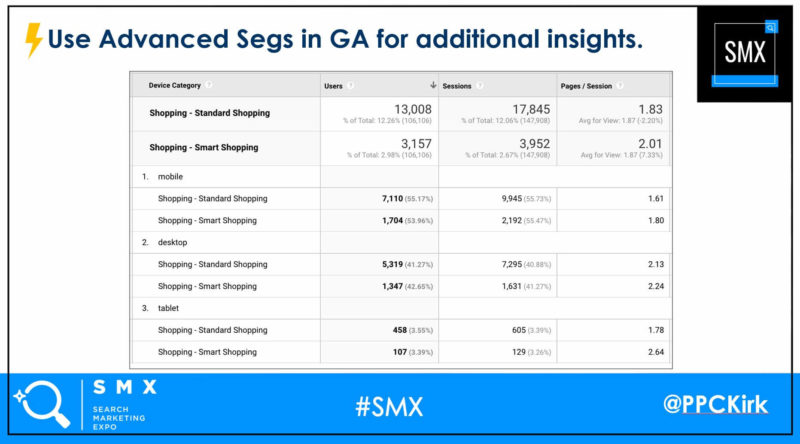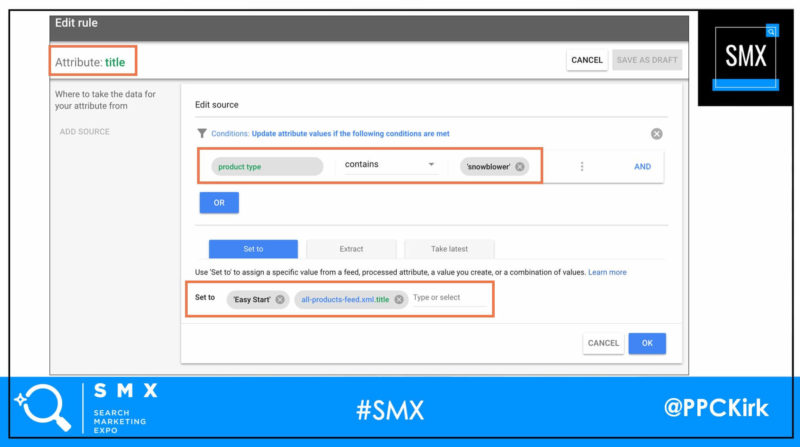Smart Shopping campaigns: How to test and extract more value from automated campaigns
Kirk Williams of Zato Marketing says Smart Shopping campaigns are worth testing when you understand how they work.

Have you gotten the hard sell? Google reps have been pushing Shopping advertisers to adopt Smart Shopping campaigns — and to even switch away from standard Shopping campaigns entirely. You shouldn’t abandon standard Shopping just yet, said Kirk Williams, owner of ZATO Marketing at SMX West in San Jose last week, but it’s probably time to start testing and understanding how Smart Shopping campaigns work.
“Smart Shopping can definitely perform well, but what you lose if you just run Smart Shopping campaigns is data that can inform other marketing efforts,” said Williams. “You still want to be running [standard Shopping and Smart Shopping] together.”
The big differences between Smart Shopping campaigns compared to traditional Shopping are automation (almost entirely) and data (very little). Google doesn’t provide data on audiences, search terms or placements in Smart Shopping campaigns.
In fact, Williams noted, Smart Shopping and standard Shopping run on two distinct codebases and are managed by two different engineering teams in separate Google offices. We know the trend is toward automation, so how can advertisers make the most of Smart Shopping campaigns? Williams offered several tactics for Smart Shopping advertisers. Here are four key ones.
Extract insights from Smart Shopping with Analytics
While Smart Shopping campaigns are a black box in many ways, Williams has some neat tricks for uncovering more data than first meets the eye.
Set up custom Channel Groupings in Google Analytics for Smart Shopping and standard Shopping Campaigns. You’ll then be able to use advanced segments to compare the two against certain dimensions.

Test Smart Shopping with Custom Labels
Use the custom labels in your product feeds to segment and test products to learn which ones perform better in Smart versus standard Shopping campaigns.
Williams suggested using custom labels to isolate higher performing or popular products with segments such as top products, most reviewed products or gateway products.
Know Merchant Center
Even if your feed uploads automatically into Google Merchant Center, there are many features and levers you can adjust for testing and optimization.
For example, use Feed Rules for testing titles. To do this, first up products for your test and control groups using custom labels in your feed. Then in Merchant Center, set up your title test via Feed Rules. Analyze performance by comparing click share, click-through rate, impression share and total eligible impressions (impressions/impression share), advised Williams.

Prove your value in the age of automation
With essentially no set-up time (82 seconds! said Williams) and the rest nearly entirely automated, what does job security look like in a Smart Shopping campaign landscape?
“There is always a market for problem solvers,” said Williams. (And Williams exemplifies this. He is ever-curious and constantly looking for ways to add value and solve problems for clients and fellow marketers.)
The key to adding value and getting more out of your Shopping efforts starts with understanding how Smart Shopping works.
Some examples: You can’t add placement exclusions to Smart Shopping campaigns, but Williams figured out that you can exclude them at the Account level and apply those to your Smart Shopping campaigns. You can also add negative keywords to Smart Shopping campaigns, you’ll just have to ask your Google rep to do it for you. And the ROAS default in these campaigns is 200%, for example. Don’t rely on defaults. Is that the right setting for your products?
Opinions expressed in this article are those of the guest author and not necessarily Search Engine Land. Staff authors are listed here.
Related stories
New on Search Engine Land